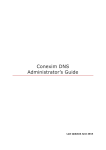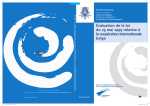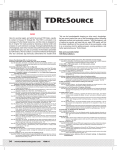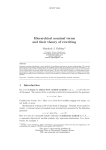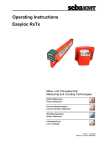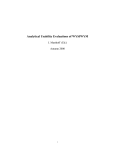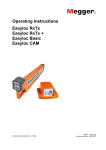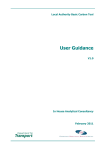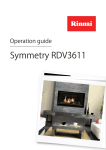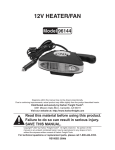Download Freight mode shift benefits values user guide
Transcript
Freight Mode Shift Benefits Values User Guide Produced in partnership with Scottish Government and Welsh Assembly Government 1st April 2009 For additional information please e-mail: [email protected] 1 2 Introduction 1. The Sensitive Lorry Mile (or SLM) values have been used in the valuation and allocation freight mode shift grants since 1991. The most recent SLM values have been in place since 2003 and will remain valid until the 31st March 2010. Mode Shift Grant Schemes The Department for Transport, the Scottish Government and the Welsh Assembly Government (the 'Administering Bodies') have three freight mode shift grant schemes whose objective is to facilitate the purchase of the environmental and social benefits that result from using rail or water transport instead of road. These are: • Freight Facilities Grants (FFG) - which helps offset the capital cost of providing rail and water freight handling facilities; • Rail Environmental benefit Procurement Scheme (REPS) - which assists companies with the operating costs associated with running rail freight transport instead of road (where rail is more expensive than road); and • Waterborne Freight Grant (WFG) - which assists companies with the initial operating costs associated with running water freight transport instead of road (where water is more expensive than road). 2. The Department for Transport in partnership with the Scottish Government and the Welsh Assembly Government has been conducting a review of the mode shift grant schemes in advance of submitting a request for state aids approval for the continuation or replacement programs from April 2010. Associated with this wider review of grant schemes we have also undertaken an in-house review of the SLM values. The values were previously reviewed by the Department and the Strategic Rail Authority in conjunction with the Scottish Executive in 2003 1 . 3. The SLM values will be replaced with effect from the 1st April 2010. Mode shift grants that are awarded for spending from that date until the 31st March 2015 will be assessed on the new Mode Shift Benefit (MSB) values that are published in this paper. 4. The review has been extensive and this paper summarises that review. A further more detailed technical paper has been published for those who wish to have a comprehensive understanding of the MSB values. For most stakeholders this paper provides all the information that is needed to use the new MSB values. 5. A key objective of the review has been to produce MSB values that are fit for use in allocating the freight grants, that are consistent with published traffic forecasts and appraisal guidance, and as far as possible reflect the best available evidence as to the value of transferring freight from road to rail or 1 The results of the review are reported in SRA (2003). 3 water in the period 2010 - 25 2 . As requested by a wide range of stakeholders, we have also sought to ensure that the MSB values do not make the process of applying for and administering the grants schemes disproportionately time consuming or costly. 6. In June 2008 the Department circulated to stakeholders Review of SLM values: Phase 1 report. The initial phase of the review had focused on identifying the scope for updating the existing SLM values to be consistent with the latest transport modelling and published appraisal guidance (WebTAG). The paper summarised the work that had been done as part of the initial phase of the review, proposing methods for updating the SLM values and inviting comments from stakeholders. We received a number of comments and these have assisted us in finalising the approach to updating the values described in this report. 7. In December 2008 a draft MSB user guide was produced and placed on the internet. This guide replaces that paper. A draft technical report was published in January 2009, the full technical report has been published alongside this paper in April 2009. It is available to download at www.dft.gov.uk/adobepdf/165226/443908/msbreviewtechpaper.pdf 8. This paper is structured as follows: Section 1 Introduction Section 2 Mode Shift Benefit values – provides the MSB values by road type. Section 3 Background - provides background about the estimation of MSB values and their use in the allocation of grants. Annex A List of Motorway links in the high value MSB band Annex B Deriving Mode Shift Benefit values – General Principles outlines the factors that have been considered in creating MSB values, focusing on factors that apply to all of the components of the values. Annex C Deriving Mode Shift Benefit values – Overview of Detailed Methods - looks at each of the components of the MSB values individually and outlines the method employed to estimate these values. 2 Whilst the values will only be used in the allocation of grants in the period 2010-2015, FFG can be allocated on the basis of flows lasting 10 years from the date of grant allocation. This means that the values could be used to value the net social benefits of transferring freight traffic up to 2025. 4 Section 2 The Mode Shift Benefit Values 9. The MSB values are segmented into four road types. There are two values for motorways, a Standard value for most motorways and a High value for those sections of motorway where congestion is substantially higher. There is a single value for all A-roads and a further value for all B, C and unclassified roads. The values are shown in table 1. Table 1. MSB values by road type. Valid from April 2010 to March 2015 Motorways High value Standard All A-roads Other roads (all B, C and unclassified roads) £0.86 £0.07 £0.74 £1.43 10. Currently the Department for Transport provides an online mapping tool to calculate the SLM values. This will not be replaced when we move to the MSB values. The Administrative Bodies will advise which routing software will be the standard for calculating MSB values during 2009. A list of the 15 Motorway sections that are in the high value category is provided in Annex A. 11. A point to note is that many short links between A-roads and between Motorway slip roads can be shown unclassified in mapping software. In such circumstances the classification of the road value will normally be based on the motorway or A road category as appropriate. (We will provide guidance in due course, however if you require clarification or confirmation of a value for a given road please contact your Administrative Body). 12. Annex B and C provide an overview of how each component of the MSB values have been calculated. For those requiring further detail a comprehensive technical paper will be produced in parallel with this paper. The technical paper will outline in detail how the value for each component of the MSB value has been calculated. A summary of the component values is provided in table 3 at the end of Annex C. 5 Section 3 Mode Shift Benefit Values – Background The values 13. Mode Shift Benefits (MSB) values have been estimated solely for use in the allocation of mode shift grants. They represent Administering Bodies' valuation of the environmental and other social benefits of removing one lorry 3 mile of freight from the road and transferring it to rail or water. In the next few paragraphs we explain why there is a social benefit to transferring freight from road to rail or water and identify the components of the social benefit 14. In deciding how to send freight an operator will compare the costs expected with the benefits expected. The costs faced by the operator, or ‘marginal private costs’, will include wages, fuel, oil, tyres and any other mileage related repair expenses, including any taxes (such as fuel duty) incurred. 15. However the operator will also impose costs on other groups in society, which are not factored into a decision about how to transport freight. These costs are referred to as 'marginal external costs'. A number of studies have looked at the external costs of road freight 4 . The key marginal external costs considered in SRA (2003), as part of the previous review of SLM values, and considered in this review, are: • • • • • • • Congestion costs Accidents costs Noise costs Climate change costs Air pollution costs Infrastructure costs Other costs (previously called “Unquantified”) 16. Previous studies have suggested that the external costs of road freight are only partially internalised in that the additional tax incurred by freight operators is less than the value of the marginal external costs they impose. In technical terms this means that for marginal increases in road freight traffic the net social costs are approximately equal to the difference between the value of the marginal external costs and the marginal level of taxation at the existing level of freight traffic. 17. Mode-shift grants reduce the amount of freight on roads but also increase the amount of freight transported by water and rail. Thus in estimating the net benefit of transferring freight away from roads we also consider the social costs/benefits associated with increasing the amount of freight using other modes. 3 Throughout this document, unless otherwise stated, ‘lorry’ refers to articulated heavy goods vehicles. 4 See Maibach et al. (2008), INFRAS (2000, 2004) and Piecyk & McKinnon (2007) for example. 6 18. In summary, the net social benefit of transferring freight from road to rail or water is made up of the benefits of reducing the amount of freight traffic on road and the costs of increasing the amount of freight traffic on other modes. For transfers of marginal amounts of freight from road to rail or water the value of the net social benefits is approximately equal to the net social cost of road freight less the net social cost of rail or water freight.5 19. The value of the marginal external costs for each mode is obtained by estimating the value of each of the main marginal external costs separately. From this an estimate of the value of the marginal change in taxation is netted off to reflect the fact that indirect taxation partially internalises the external costs of freight traffic, providing a net social cost by each mode. The marginal net social costs of rail / water is netted off from the net social costs of road freight to provide the estimate of the marginal social benefit of transferring freight from road to rail or water. 20. In practise the net social benefit of induced modal shift will vary by time and location. To account for the most significant variation in location the MSB values vary by road type. To account for the variation in time we have calculated the values we have published by weighting in accordance with the occurrence of articulated heavy goods vehicles on the road network (no similar weighting has been used for water or rail). Use of MSB values in Mode shift grant allocation 21. MSB’s will operate in the same way as is done now with the current SLM values. To calculate the benefit of mode shift an applicant is required to specify the origin and destination of each lorry movement and determine the distances by road type of the most likely road route. These distances are then multiplied by the relevant MSB values and summed to provide an estimate of the net social benefit of transferring the lorry load of freight from road to rail or water. 6 22. Often when freight is transported by rail or water it will be necessary to transport the freight to/from the rail terminal or port by road at one or both ends of the journey. The origin and destination of these 'local road distribution' also needs to be valued and the associated external costs subtracted from the net social benefits of removing the original lorry trip to yield the estimate of the net benefits of transferring the lorry load of freight from road to rail or water. 23. Since the MSB values take account of the net social costs of moving freight by rail or water, applicants will not normally be required to estimate the net social costs of rail/water separately. In effect this approach is consistent with the assumption that the distance the freight travels by rail or water is broadly similar to the length of the road journey removed (after adjusting for 5 The Net Social Cost of Road freight is composed of the marginal external cost of road freight Less the marginal tax on road freight. The Net Social Cost of Rail or Water freight is composed of marginal external cost of rail or water freight Less the marginal tax on rail or water freight 6 For the REPS scheme and its likely replacement the Administrative bodies will estimate the net social benefits of removing lorry trips for the routes covered by the scheme. 7 any local road distribution legs at the end of the rail or water journey). Our assessments show that this approach is broadly accurate in most cases. However, there are rare circumstances where the separation of the calculations will be appropriate. We do not wish to place undue burdens on applicants or administrators so it has been decided that separate valuations by mode will only be required in those cases where it is determined by the administrative body that the road and rail or water journey distances vary by more than 10% from each other. 24. The amount of grant will remain capped by the Administrative Bodies estimate of the value of the mode shift, calculated by using the MSB values as described above, and by 'financial need'. The 'financial need' is calculated for each flow included in an application. It is defined as the difference between the total costs of the rail or water based solution and the total costs that would be incurred if the traffic were moved by road. Capping the grants by financial need ensures that the grant paid is the minimum necessary to bring about the mode shift benefits. State Aid rules prevent any grant exceeding the value of the benefits obtained from paying the grant. Within this constraint the Administrative Body will allocate its mode shift grant spending on the basis of each application’s benefit-cost ratio (BCR), where the BCR is calculated by dividing the estimated value of net social benefits by the amount of grant that is bid for. 25. A concern has been raised about how these values would be used in the event of a fundamental change of circumstances. (Major changes in the taxation system or the introduction of comprehensive road pricing were cited as possible examples). If exceptional and fundamental changes occur that alter the basis for the calculation of the external costs, it may be the case that the MSB values would need to be withdrawn for new applications and reestimated based on the changed circumstances. 8 Annex A. List of motorway sections that attract High MSB values High MSB values will apply between the junctions stated on the following motorways. A map highlighting the sections included and a full table with associated mileages between all junctions will be available for download in January 2009. Junction Road Junction Scotland M8 8 A8/M73 19 North West M60 M6 M62 M56 M62 All 15 10 1 18 A500 M6 M60 M60 21a 12 9 21 M62 M62 M6 Rochdale Midlands M6 M42 M1 4 3a 15 M42 M40 A508 10a 7 17 M54 M6 M45 Yorkshire M1 M62 28 26 A38 A642 35a 30 A616 M606 South East M25 M4 M3 All 7 14 A4 M27 4b 9 M25 A34 Wales M4 30 A4232 33 9 A4232 Road Annex B The General Principals of deriving Mode Shift Benefit Values 26. This annex outlines the general principals that we have applied to a number of issues that are relevant to the way we have estimated all of the components of the MSB values. This annex is a summary of the key points that will be published in more detail in a complementary technical report. If more detail is required please refer to the technical report. Variation in MSB values between 2010 and 2015 27. There has been broad support from stakeholders and the Administrative Bodies that we should produce MSB values that look at impacts collectively through time. Therefore it was decided to provide a single MSB value for each road category for the 2010 – 2015 period. 28. The MSB values presented in table 1 represent 2015 values in 2010 prices. This provides a simple single set of values that will be used to value freight removed from the road network in the period 2010 to 2015 regardless of when the application an made. We considered other options, but on examination it was determined that using 2015 values in 2010 prices was the most suitable approximation as it results in a similar amount of grant being paid to applicants over the five year period as would be the case if 2010 values and prices were used to value the benefits in 2010, 2011 values and prices were used to value the benefits in 2011 and so on up to 2015. Vehicle Types 29. We considered which sort of freight vehicles the mode shift schemes effect (all HGV vehicles or just articulated vehicles). Analysis indicated, and this was comprehensively supported by stakeholders, that new MSB values should be based on estimates of the external costs of removing an average articulated lorry from the road. Therefore all MSB analysis was based upon the removal of just Articulated freight vehicles rather than all HGV’s. Unit of Account 30. MSB values will be used to determine the value for money of grant applications relative to each other, the value for money of mode shift relative to other spending options and the maximum amount that the Administering Body would be willing to pay in grant to bring about specified amounts of modal shift. 31. To ensure consistency with the Department’s published WebTAG guidance on units of account the MSB values are expressed in the factor cost unit of account both to determine the maximum amount we would be willing to pay in grant, and for use in appraisal. 10 Mode shift grants and road freight forecasts 32. Road congestion is the largest single component of the MSB values. 33. In producing new MSB values we have used traffic forecasts for 2010, 2015 and 2025 from the Department's National Transport Model. It is likely that these forecasts factor in, albeit implicitly, a continuation of the mode shift grants over this period. It is difficult to determine the extent to which the forecasts factor in a continuation of the grant scheme. In so far as the forecasts do factor in the continuation of the mode shift grants they will understate the level of freight using the roads, and therefore the total level of road traffic, in the absence of the grants. Given the positive relationship between marginal external congestion costs and the level of traffic this would lead to us underestimating the congestion component of the MSB values. 34. To correct for this factor we have assessed the impact of the mode shift grants over sample sections of the road network and provided an uplift of 3% to the road congestions values to account for this factor. (The technical paper contains further information about the calculation and its rationale). 11 Annex C Deriving Mode-Shift Benefit Values – Detailed Methods 35. This annex outlines the approach that has been taken to estimate each of the components of the new MSB values has been estimated. This annex is a summary of the key points that will be published in more detail in a complementary technical report. If more detail is required please refer to the technical report. Marginal External Costs of Road Freight Marginal External Cost - Congestion 36. When additional HGV traffic joins a road it imposes costs on other vehicles in the form of longer journey times. In addition, the reduction in speeds will also affect other vehicles' operating costs. For example, a vehicle’s fuel consumption will vary with speed, so a reduction in speed will change that vehicle’s fuel consumption, and hence fuel costs. 37. As well as reducing average journey speeds there is evidence that increased traffic also increases the variability of journey speeds, often reducing the reliability of journey times 7 . Greater variation in speed will also affect operating costs. For example, acceleration and deceleration lead to increased use of fuel, as well as wear and tear on other parts of vehicles. 38. We have based the congestion element of the new MSB values on outputs from the DfT’s National Transport Model (NTM). This approach ensures consistency with both the latest traffic forecasts and the guidance on valuing vehicle operating costs and changes in travel time given in WebTAG. For MSBs we used the NTM to produce traffic forecasts for 2015, the year in which the estimates are required. 39. In our modelling we have uprated the journey time component of the external cost estimates by 50% on rural motorways and rural trunk roads and 20% on other roads to reflect the impact of additional HGV traffic on journey time reliability. These uprates were also used to derive the existing SLM values and they were used to value reliability benefits as part of the Eddington study. 8 The values for congestion by road type are shown in table 3 at the end of this annex. Marginal External Cost - Climate Change 40. The addition of a lorry to the road network will lead to an increase in greenhouse gas emissions. The additional vehicle will also affect the speeds, and hence fuel consumption, of other vehicles on the road, further affecting greenhouse gas emissions. 7 8 See Arup (2003) for example. See Annex E of DfT (2006b) for example. 12 41. The National Transport Model (NTM) estimates the level of carbon emissions associated with each set of traffic forecasts it produces using the parameters and relationships contained in WebTAG. We have used this output to estimate the Marginal External Cost for Climate Change of articulated HGVs. 42. We have valued this change in carbon emissions using published Defra guidance on the shadow price of carbon - Defra (2007b) - to give an estimated value of the Marginal External Cost of Climate Change. Table 2 shows the shadow prices of carbon for 2015 that we have used in our analysis: Table 2: Shadow price of carbon (in tonnes CO2 equivalent, 2010 prices) 9 Year Shadow Price of Carbon 2015 £32.54 Source: Defra (2007b) 43. The values for climate change per lorry mile by road type are shown in table 3 at the end of this annex. Marginal External Cost - Noise 44. Noise is emitted from vehicles' engines, from the interaction between their tyres and the road surface, and from intermittent sources, such as braking. Additional traffic affects noise levels directly through the noise it emits itself and indirectly through its impact on the noise emitted by other vehicles as a result of changing their average speeds. Noise affects amenity and may have adverse impacts on human health through a variety of direct and indirect effects. 45. The welfare module of the NTM 10 estimates the impact of changes in traffic levels on noise costs using marginal external cost values (in pence per vehicle km) based on data collected for Samson et al. (2001). This is also the approach that was employed to derive the noise component of the SLM values and the noise values presented in TAG Unit 3.13.2: Guidance on Rail Appraisal - External Costs of Car Use 11 . 46. Samson et al. (2001) provided high and low estimates of the marginal external noise costs. For MSB values we have taken the mean of the low and high values provided for articulated HGVs to provide an estimate of the Marginal External Cost – Noise. This was then adjusted to 2015 values by uprating the original 1998 values using GDP growth. The values for noise by road type are shown in table 3 at the end of this annex. 9 The mass of Carbon emitted can be translated into the mass of CO2 by multiplying by 3.67 (equal to 44/12, the relative mass of Carbon to Carbon Dioxide). 10 See DfT (2005b) for details. 11 Please note that whilst the existing SLM values are based on the arithmetic mean of the high and low values produced by Samson et al. (2001) the marginal external cost values used in the welfare module and presented in TAG unit 3.12.2: Guidance on Rail Appraisal External Costs of Car Use are based on the geometric mean. This serves to bias the numbers downwards relative to the existing SLM values. 13 Marginal External Cost - Accidents 47. Accidents impose a range of costs on society. The Department’s guidance on assessing accident risks in DfT (2007a) highlights the following categories: medical and healthcare costs; lost economic output; pain, grief and suffering; material damage; police and fire service costs, insurance administration; and legal and court costs. 12 48. A proportion of the social costs are factored into the operator’s decision to send its freight by road. For example, the insurance system ensures that the victims of any accident involving a lorry are at least partially compensated for the costs they bear 13 . For the Marginal External Cost - Accidents we are only interested in the change in accident costs that is caused by the additional traffic but that is not already factored into the operator’s decision to send its freight by road. 49. The welfare module of the NTM estimates changes in accident costs using Marginal External Cost - Accidents values (in pence per vehicle km) based on Samson et al. (2001). This is also the approach that was used to estimate the accident component of the existing SLM values and the MEC - A values presented in TAG Unit 3.13.2: Guidance on Rail Appraisal - External Costs of Car Use. 50. Samson et al. (2001) provided high and low estimates of the marginal external accident costs in 1998 prices and values. For MSB values we have taken the mean of the low and high values provided for articulated HGVs to provide an estimate of the Marginal External Cost – Accidents. After consideration of the options, this value has been adjusted to 2015 values by uprating the original 1998 values in line with inflation. The values for accidents by road type are shown in table 3 at the end of this annex. Marginal External Costs - Infrastructure 51. Vehicles cause damage to the road infrastructure, the extent of that damage varies depending on the exact vehicle specification, road type and road conditions. Additional use by large articulated vehicles will increase the frequency that road maintenance is required, increasing the cost to the local authorities and agencies responsible for maintaining the road network. 52. In a similar way to Noise and Accident factors, the welfare module of the NTM estimates changes in infrastructure costs based on Samson et al. (2001). This is also the approach that was used to estimate the infrastructure component of the existing SLM values and the infrastructure values presented in TAG Unit 3.13.2: Guidance on Rail Appraisal - External Costs of Car Use. 53. We have updated the calculations performed in Samson et al (2001) using the latest data on road maintenance costs, published in DfT (2008d) 12 Accidents are also one source of journey time variability. We have included the costs of this variability as part of our estimation of the MEC – Congestion. 13 There is some debate as to the extent to which the social costs of accidents are perceived by road users in deciding to use the road. See Maddison et al. (1996) for a discussion. 14 and on the characteristics of different road vehicle types, published in DfT (2006c), DfT (2007d) and DfT (2008b). We have used the average infrastructure costs estimated for articulated vehicles by road type to generate the values that are shown in table 3 at the end of this annex. Marginal External Costs – Pollution 54. Vehicle engines emit many types of air pollutants, including oxides of nitrogen (NOx), particulate matter smaller than ten nanometres (PM10), volatile organic compounds (VOCs) such as benzene and 1,3-butadiene, Carbon Monoxide (CO) and sulphur dioxides (SO2). Brake and tyre wear can also cause pollution in the form of particulate matter. These pollutants can have health and environmental effects. 55. Additional freight traffic creates air pollution in two ways. First, there are the pollutants that are emitted by the vehicle itself - primarily through the consumption of fuel. Secondly the additional HGV traffic can affect the fuel consumption of, and therefore the amount of pollutants emitted by, other vehicles. 56. Using values per tonne of NOx and PM10 that were used in Defra (2007a), we have based the pollution component of the new MSB values on outputs from the NTM as the NTM estimates the level of NOx and PM10 emissions associated with each set of traffic forecasts it produces. This approach does not take account of changes in any of the other pollutants emitted by HGVs. We have examined other sources of evidence and have uplifted the pollution values by 4% of the external costs associated with NOx. The values for pollution by road type are shown in table 3 at the end of this annex. Other Marginal External Costs 57. The Other Costs element of the MSB values reflect a range of external costs that would normally be considered and assessed in a full scheme appraisal dealing with an individual project, but are more difficult to value in a systematic way that is appropriate for a grant scheme with many relatively small applications. If a provision is not made to cater for these elements, mode shift values would be systematically undervalued. 58. Therefore, just as with existing SLM values, we are including a provision for this. However, unlike the “Unquantified” element of the SLM’s, the Other Costs component of the Mode Shift Benefit values will be a common uplift across all road types and will be based on the weighted average over all road types and the externality value attributed to water and rail. 59. The evidence we have identified (primarily Maibach et al. 2008) allows us to estimate a simple pence per mile uplift. The components we have based our valuation on for road are: • Up and downstream processes • Soil and Water Pollution • Nature and Landscape 15 • • • • Driver frustration / stress Fear of accidents Restrictions on cycling and walking and Community severance Visual intrusion 60. The values for Other external costs by road type are shown in table 3 at the end of this annex. Road Freight Taxation 61. To be compatible with other appraisals and valuations done within Government, we need to net off the effect of taxation within the MSB values. Road freight operators pay taxes that help to internalise some of the marginal external costs of their road use. These taxes are in the form of vehicle excise duty and fuel duty. Value added tax is paid by freight operators but is not relevant here as it can later be reclaimed. 62. It is only the taxation paid by the operator of the marginal freight vehicle, which is included in this adjustment. This is because the mode shift grants ensure that the operator of the marginal unit of freight is compensated for the difference in costs of using rail or water rather than rail and the loss of tax to the exchequer is not reflected in a gain to the operator (there is no user benefit). This is not true of the taxation paid by other vehicles because any changes in the fuel duty revenue received by the exchequer are exactly offset by changes in tax payments borne by the road users. 63. The NTM does not specifically model the impact of changes in traffic on taxation. Instead we have estimated the fuel duty element of the additional tax paid indirectly by working backwards from the estimate of the carbon emitted by the vehicle. We have calculated the change in VED using NTM output alongside other data. 64. It is not possible to predict unannounced future taxation rates therefore we have used fuel duty rates announced at the 2008 budget. This implies a rate of 44.7 pence per litre from 2010 onwards (in 2010 prices). The values of tax effects by road type are shown in table 3 at the end of this annex. 65. Note that these taxation values are expressed as a negative, and have the effect of reducing the overall MSB value. Marginal External Costs of Rail and Water Freight 66. When creating MSB values that measure the net social costs of road freight traffic for mode shift we need to take into account the costs imposed by the alternative method of movement. In essence we need to calculate similar factors for rail and water as we have for road and adjust the values accordingly. As we are estimating the benefits of mode shift in terms of the benefits of moving one lorry mile of freight from road to rail or water we have created estimates for rail and water for the costs of transporting freight in lots equivalent to one lorry load. We have tried as far as possible to ensure that 16 the method we have used is consistent with that used to estimate the marginal external costs of road freight. 67. Consideration was given to producing separate MSB values for rail and water freight based on the different impact produced by each mode. However, for simplicity and on the basis of the evidence we have been able to obtain we believe there is a strong case to assume, for the purposes of allocating freight grants, that the marginal external costs of water and rail freight movements per lorry mile equivalent are broadly similar. As a result this similarity we have built up our detailed valuation of the rail and water impacts solely on assessment of rail freight components. (Further details are available in the Technical Paper). 68. Maibach et al. (2008) provides a comprehensive overview of previous European studies that have attempted to estimate the marginal external costs of rail freight. It highlights noise, climate change and air pollution costs as being the most significant. We have focused on estimating values for these three categories of external costs. 69. The values for rail and water externalities are consistent over all road types. Table 3 summarises the net external costs for rail & water into a single value (5.7 pence per lorry mile), Table 4 breaks that down into values for each individual component. Marginal External Cost - Noise 70. The approach we have taken to estimating the Marginal External Costs - Noise of rail freight is the same as that we have used for road freight. Samson et al. (2001) provided high and low estimates per freight train kilometre in 1998 prices and values. We have taken the mean of these values and used it to derive values for 2015 by assuming the Marginal External Costs - Noise increase through time in line with GDP growth. Marginal External Cost - Climate Change 71. We have based our estimate of the Marginal External Costs – Climate Change per rail freight train kilometre on the assumption that the fuel consumption remains constant at 4.7 litres per kilometre for bulk trains 14 and 4.8 litres per kilometre for intermodal trains. These assumptions are based on evidence provided to Freight and Logistics Division’s by freight operating companies. 15 We have translated the estimated fuel consumption into an estimate of the carbon emitted per freight train kilometre by using the carbon intensities of fuel (in grams of carbon per litre) provided in TAG Unit 3.3.5: The Greenhouse Gases Sub-Objective. Finally, we have valued the carbon emitted per freight train kilometre by using the published Defra guidance on the shadow price of carbon – Defra (2007). 16 14 This is an average of fuel consumption for a fully laden train in one direction and an empty return. We have tested the sensitivity of our estimates to the use of alternative assumptions about the fuel consumption of bulk and intermodal trains. 16 We have combined our estimates of the carbon emitted per train kilometre with assumptions about the typical number of lorries removed by a typical freight train to derive estimates 15 17 Marginal External Costs – Pollution 72. To be consistent with the approach we have taken for road freight, in estimating the Marginal External Costs – Pollution we have focused on NOx and PM10. We have based our estimates on the emissions of these gases per train kilometre at the 2006 levels reported in the National Atmospheric Emissions Inventory 17 . We have valued our estimates of NOx and PM10 emitted per freight train kilometre using the values per tonne that were used in Defra (2007a). This is consistent with the approach we have taken for road freight. Other Marginal External Costs 73. In considering the Other Marginal External Costs for rail and water we have followed the same approach to that we used to assess the road values. The evidence we have identified (primarily Maibach et al. 2008) allows us to estimate a simple pence per mile uplift. The relevant components that have based the valuation on for rail and water are: i. Accident Costs ii. Up and downstream processes iii. Soil and water pollution iv. Nature and Landscape v. Driver frustration / stress vi. Fear of accidents vii. Restrictions on cycling and walking and Community severance viii. Visual intrusion Non Road Freight Taxation 74. In the same way as road operators, rail freight operators pay taxes on fuel which, to some extent, cover the external costs which they impose on others. We have used the latest gas oil duty rates announced at the time of the budget. 18 In deriving estimates beyond 2010 we have assumed that the duty on gas oil increases at the same rate as duty on road diesel. We have estimated the amount of duty paid per kilometre by multiplying the fuel consumption of a typical freight train (in litres per kilometre) by the duty rate per litre of fuel. 17 18 See http://www.naei.org.uk/data_warehouse.php. For details, please see http://www.hmrc.gov.uk/budget2008/bn71.pdf 18 Table 3. MSB values by road type and component. (pence per lorry mile) Motorway High Low Congestion Accidents Noise Pollution Climate Change Infrastructure Other (road) Taxation Rail or Water costs Total A roads Other roads Weighted average 19 100.2 0.5 8.6 1.9 3.6 4.7 6.4 -34.4 -5.7 24.1 0.5 6.0 1.8 3.6 4.7 6.4 -34.5 -5.7 75.9 5.7 7.2 3.3 4.2 10.8 6.4 -33.6 -5.7 85.2 5.6 9.1 3.8 4.2 68.7 6.4 -34.8 -5.7 52.4 2.8 7.0 2.5 3.8 9.0 6.4 -34.1 -5.7 86 7 74 143 44 (Total MSB Values by road type are rounded to nearest penny) Table 4. MSB component values for rail and water. (pence per lorry mile) Noise 2.59 Pollution 2.24 Climate Change 1.31 Other 1.23 Taxation -1.70 Total 5.7 References A full list of the references used in the production of the MSB values is available in the Mode Shift Benefits Technical Paper that is available to download from the Department for Transport web site at www.dft.gov.uk/adobepdf/165226/443908/msbreviewtechpaper.pdf 19 Weighted by articulated goods vehicle kilometres and their use of the road network 19




















